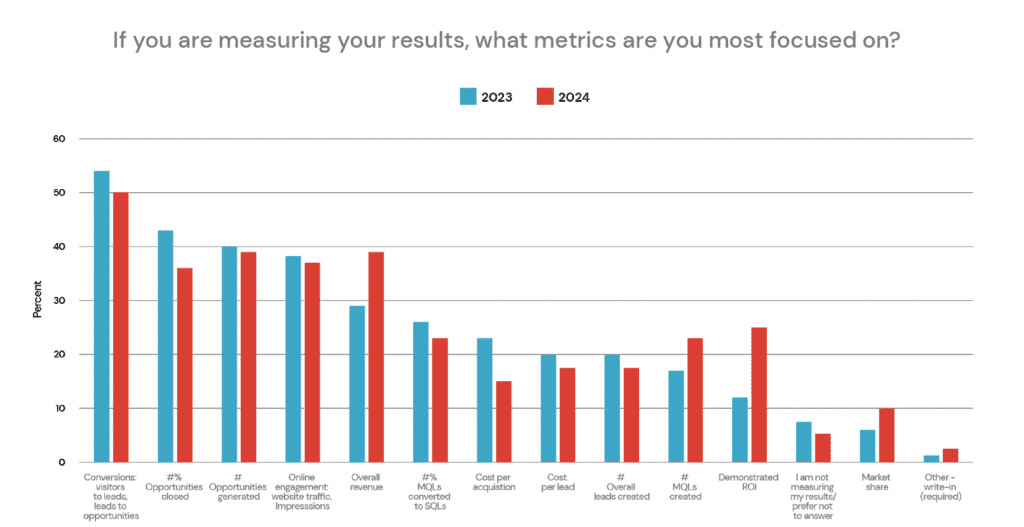Measuring Marketing Success: Key Metrics Supply Chain Marketers Should Track
It’s a data-driven world, and we’re all just living in it. But properly tracking and using that data can be the difference between success and failure.

And when it comes to supply chain marketing, we have to look at the metrics we’re measuring and figure out how to perform better so we can help achieve overall company goals.
The good news is, as an industry, we’re learning the importance of marketing metrics and doing a better job tracking them. According to our recent 2024 Supply Chain Marketing Industry Outlook and Trends Report, supply chain marketers’ focus on demonstrated ROI increased significantly over the past year, rising from 12% to 25%. The percentage of respondents who answered “I am not measuring my results” dropped from 8% to 5%.
Popular Supply Chain Marketing Metrics

The metrics your company measures and tracks should align with your overall marketing and business goals. Our survey found that conversions (visitors to leads and leads to opportunities) are the most popular metric being used to measure success for the second year in a row.
Opportunities generated and overall revenue tied for second place in our survey. Those were followed by online engagement, and opportunities closed. When looking at all of these top metrics, you can see their correlation. Online engagement leads to more opportunities generated. The more opportunities generated, the more opportunities closed, which leads to conversion. Of course, all of those things then lead to higher overall revenue, which is a goal of every business.
So, the biggest question then becomes, how can we, as marketers, increase lead conversion to drive overall revenue growth for our companies? We have some ideas on that.
5 Tactics to Increase Conversions
Measuring marketing success is essential for supply chain companies to stay competitive in today’s market. (Click here for an example marketing metrics scorecard.)
However, measuring conversions is only the beginning. We have to take that information and learn from it. We also need to figure out ways to increase conversions to drive revenue growth. And, as with most things, it takes time, effort, and a solid plan of attack, or tactics.
Here are a few marketing techniques to increase conversions and, by extension, revenue (hopefully, anyway).
1. Know Your Audience: Before you can effectively talk to your target customers, you have to understand who they are, their challenges and pain points, how they digest information, and what their decision-making or buying process looks like.
Start by analyzing your target lists, creating ideal customer profiles, and mapping the buyer journey. Then, match your content to what you find.
2. Send the Right Message: While developing content for your target audience is a good start, you also have to ensure your content delivers what you say it will. If you send an email promising tips on how to implement the best transportation management system, it has to provide that information or at least link to a blog or guide that does.
3. Stay Engaged: Driving traffic to your website or garnering high email open rates, isn’t enough to increase conversions. People rarely convert right away. You have to engage them. This can be done in a variety of ways:
- Use chatbots to engage website visitors in conversation and answer their questions on the spot, which not only keeps them on your site longer but can provide valuable insight into what may be missing from your current content. customer and an additional vehicle for identifying your prospects.
- Use your social media accounts to showcase your thought leadership, brand personality, and engage with your customers and prospects. These channels are great for measuring engagement and increasing brand awareness. Post multiple times per week. Use polls. Try new things, like videos or profiling team members. Anything that can provide a human element creates that connection and engagement with your audience.
- You can also use retargeting ads to engage with leads who have shown interest but never converted. They are a great way to keep your brand top-of-mind for prospects still in their buying journey.
4. Nurture leads with targeted content: Most importantly, in order to drive conversions, you must nurture your leads. Develop interactive content such as quizzes, assessments, or calculators that provide value to your leads while engaging them with your brand.
You can also use your campaigns to identify leads who are most likely to convert into customers. By establishing a lead scoring system, you can focus your efforts on opportunities in the funnel with the highest potential for conversion.
5. Make it Quick: While focusing on the content and how you’re reaching out is important, you also have to provide the information quickly, or you’ll lose people before they even get engaged. This includes fast page loading speeds, putting your CTA above the fold (don’t make people scroll to get their conversion information), clear and concise information, easily digestible facts and figures, compelling graphics, and multiple ways to convert.
If you do get a prospect to scroll down your website or email, you don’t want them to have to revert back to the top of the page to convert, there can be a pop-up that follows them, or multiple options throughout. Give them downloadables, incentives, buttons, or forms. Just make it quick and easy and without a hassle.
Charting a Path to Future Marketing Success
Success in supply chain marketing hinges on the adept tracking and utilization of pertinent metrics. As evidenced by our recent industry report, there’s a notable shift toward a more data-centric approach, with a significant increase in the focus on ROI measurement.
Crucially, the metrics we choose to prioritize must seamlessly align with our marketing and business goals. Conversions, opportunities generated, and overall revenue emerge as paramount indicators of success, interconnected in a symbiotic relationship that underscores the importance of engagement. Yet, measuring these metrics is merely the initial step; true success lies in our ability to glean insights and implement strategies that enhance conversion rates, thereby propelling revenue growth.
With targeted tactics such as audience understanding, message alignment, sustained engagement, lead nurturing, and optimization for speed and convenience, supply chain marketers can navigate this data-driven terrain with confidence, driving tangible results and sustaining competitiveness in an ever-evolving marketplace. In essence, by embracing the power of metrics and deploying strategic initiatives, supply chain marketers are poised to not only measure success but to shape it actively, charting a course toward sustained growth and prosperity in the years ahead.
Interested in the Full Report?
Click the button below to access more information about the survey.



